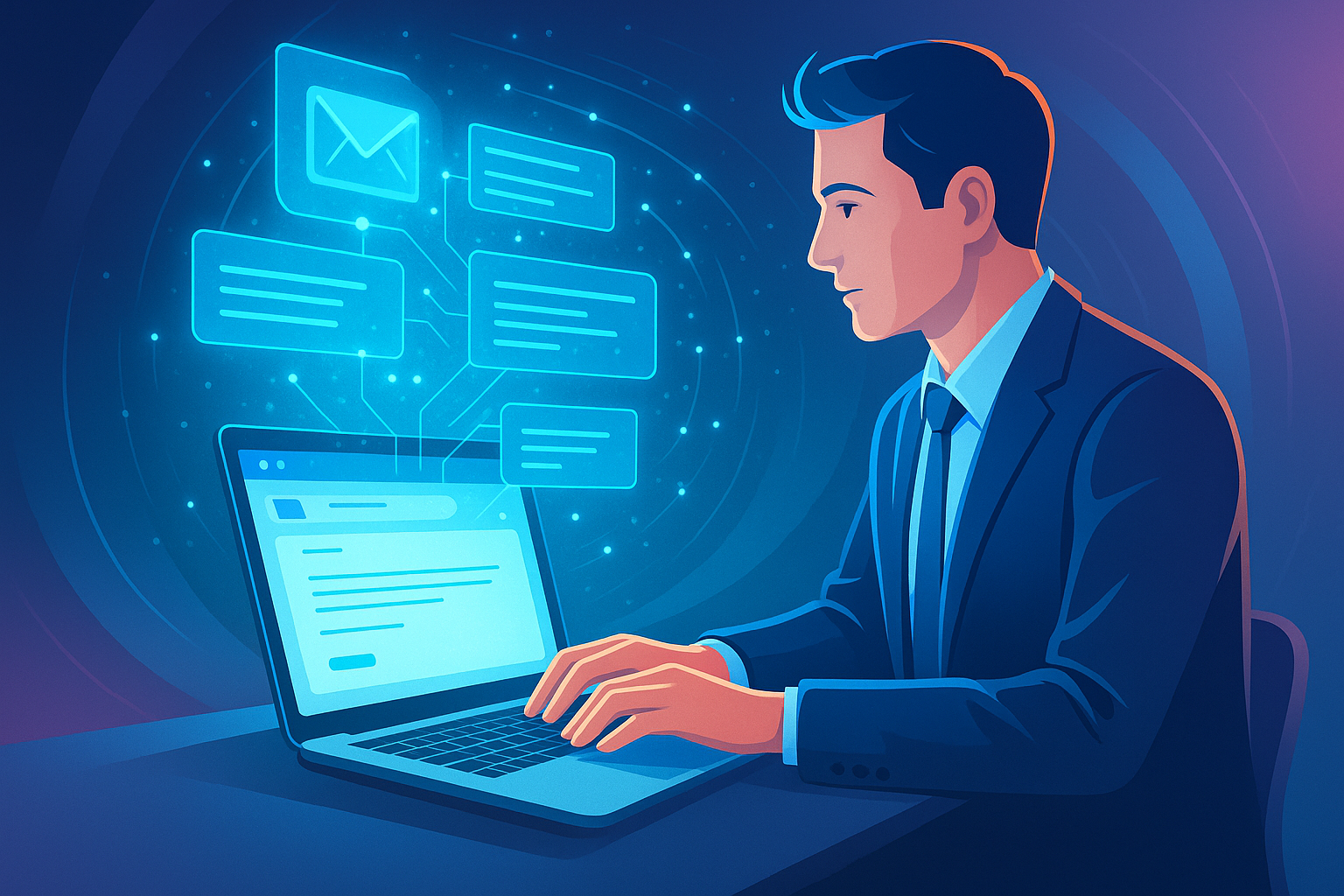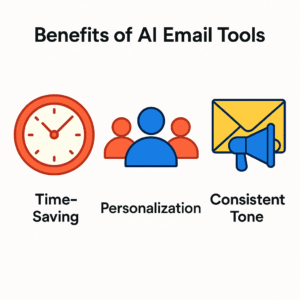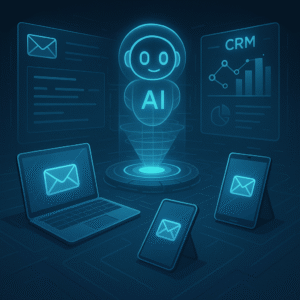- What Is an AI Email Writer and How Does It Work?
- Benefits of Using AI for Email Writing
- Free AI Email Writer Tools to Try
- Best Practices for Writing Effective Prompts
- Examples of Prompts: Bad, Good, Best
- Case Studies: Freelancers and Businesses Leveraging AI Email Writers
- Common Mistakes and How to Avoid Them
- Ethical Considerations
- Future Trends: Where AI Email Writers Are Heading
- Conclusion: The Time to Embrace AI Email Writers
Introduction: The Rise of AI Email Writing in 2025
Email remains the backbone of professional and business communication. Even with the rise of instant messaging apps and collaboration platforms, email continues to dominate when it comes to formal exchanges, client outreach, and marketing campaigns. However, drafting effective emails for marketing, sales, or customer support still takes significant time and effort.
This is where AI email writers have become game changers. In 2025, advanced AI tools can generate professional, personalized, and persuasive emails within seconds. For freelancers, small business owners, and marketing teams, these tools are now essential productivity boosters, saving valuable hours, enhancing quality, and allowing outreach at scale without losing the personal touch.
In this guide, you will learn what AI email writers are, how they work, their key benefits, and the best practices to use them effectively. You will also see examples of prompts, free tools worth exploring, and how this technology connects to other AI advancements like Prompt Engineering and ChatGPT Agent.
What Is an AI Email Writer and How Does It Work?
An AI email writer is software powered by machine learning and natural language processing (NLP) models such as OpenAI’s GPT‑4 or Google’s Gemini. These tools generate emails based on user instructions, adapting tone, structure, and content to meet specific goals like sales outreach, follow‑up reminders, or customer support replies.
How AI Email Writers Operate
Prompt Interpretation: The AI reads and understands your request, identifying tone, purpose, and key elements.
Content Generation: It produces emails based on extensive training data, generating results that closely resemble human writing.
Context Awareness: Many tools can maintain context across multiple interactions, which is helpful for email series or follow‑up communication.
Personalization Features: Some tools integrate with CRM systems to automatically include names, company details, and purchase history.
Editing and Refinement: Most advanced AI writers allow you to regenerate, shorten, or expand drafts until they are perfect.
Benefits of Using AI for Email Writing
Save Time and Increase Output
Manual email drafting can consume hours each day. AI cuts this down dramatically, freeing professionals to focus on strategy and building client relationships.
Personalization at Scale
AI can create hundreds of unique emails, tailoring subject lines and content to specific demographics or user behavior.
Improve Consistency and Tone
Whether you need warm customer service responses or formal B2B communications, AI ensures every email aligns with your brand’s tone of voice.
Enhance Creativity
Struggling with subject lines or calls to action? AI can generate endless variations and creative ideas that help your messages stand out.
Seamless Integration
Modern AI email writers connect effortlessly with Gmail, Outlook, and CRM platforms, letting you create and send emails directly within your workflow.
Free AI Email Writer Tools to Try
Several AI email writers provide free plans, making them ideal for freelancers and small businesses testing this technology. Here are three worth exploring:
-
Rytr – A lightweight tool with built‑in email templates, customizable tones, and free monthly credits.
-
Flowrite – Specializes in professional email responses and integrates directly with Gmail for real‑time drafting.
-
Writesonic – Offers free credits and creates not only emails but also marketing copy and subject line suggestions.
These tools demonstrate just how accessible AI‑powered email writing has become, even for those on tight budgets.
Best Practices for Writing Effective Prompts
The quality of AI‑generated emails depends largely on the clarity of the prompts you provide. Follow these guidelines to achieve the best results:
Be Specific About Purpose
Bad: “Write an email to my client.”
Good: “Write a polite reminder email to my client about their overdue invoice.”
Define Tone and Audience
Indicate whether the email should be formal, friendly, persuasive, or empathetic.
Include Essential Details
Add information such as the recipient’s role, context, deadlines, offers, and desired actions.
Set Length and Structure
Mention if you want a brief note or a detailed email, and specify if subject lines are required.
Refine Through Iteration
Generate multiple drafts, refine them, and combine the strongest elements into your final version.
Examples of Prompts: Bad, Good, Best
Crafting prompts effectively is the difference between generic AI output and professional-quality emails. If you’re new to the concept of building structured prompts, see our detailed Prompt Engineering guide for an in-depth explanation of how context, role assignment, and constraints influence results.
Marketing Email
-
Bad Prompt: “Write about a sale.”
-
Good Prompt: “Write a 200-word email announcing a 20% sale on all clothing.”
-
Best Prompt:
“Act as a professional marketer. Write a 200-word email announcing a 20% summer sale for our eco-friendly clothing brand. Highlight sustainability, target young adults, and include a strong CTA to shop now.”
Cold Outreach
-
Bad Prompt: “Send email to potential client.”
-
Good Prompt: “Introduce my graphic design services to a bakery.”
-
Best Prompt:
“You are a branding expert. Write a 150-word cold email to a local bakery owner introducing my graphic design services, highlighting my past work with artisan food brands, and inviting them to view my portfolio.”
Customer Support
-
Bad Prompt: “Reply to customer.”
-
Good Prompt: “Apologize for a late shipment.”
-
Best Prompt:
“Act as a support representative. Write an empathetic email apologizing for a delayed kitchenware shipment, offering an updated ETA and a 10% discount code.”
Case Studies: Freelancers and Businesses Leveraging AI Email Writers
Freelancer Scaling Outreach
A freelance consultant reduced daily email drafting from three hours to just thirty minutes by using AI email writers. Personalization improved significantly, response rates rose by 40 percent, and client acquisition accelerated.
E‑commerce Automating Customer Service
An online retailer integrated AI‑generated replies into their support system, automatically handling 60 percent of common queries and cutting customer wait times in half.
Common Mistakes and How to Avoid Them
Relying Only on AI: Always review drafts for tone, accuracy, and brand alignment.
Using Vague Prompts: Lack of detail produces generic results; add context and specifics about the audience.
Skipping Personalization: Small touches, such as addressing recipients by name, can dramatically increase engagement.
Ignoring Compliance Rules: Ensure all marketing emails follow GDPR, CAN‑SPAM, and relevant local regulations.
Neglecting A/B Testing: Experiment with AI‑generated subject lines to optimize open rates.
Ethical Considerations
Privacy
Do not share sensitive customer data with AI tools unless they comply with strict privacy and security standards.
Authenticity
AI‑generated drafts should be reviewed and edited by humans to maintain a genuine, empathetic tone.
Avoiding Spam
AI can create large volumes of emails, but sending irrelevant or excessive messages can damage your sender’s reputation.
Future Trends: Where AI Email Writers Are Heading
CRM‑Driven Personalization: AI will leverage live customer data to deliver hyper‑personalized messages.
Multimodal Content: Expect more emails combining AI‑generated text with visuals or short videos.
AI Agents Managing Campaigns: Autonomous tools like ChatGPT Agent will handle planning, writing, and analyzing entire campaigns.
Continuous Optimization: Real‑time feedback will help AI tools adjust strategies for even better results.
Conclusion: The Time to Embrace AI Email Writers
AI email writers have moved from being optional to becoming transformative tools for modern professionals. They save time, enhance personalization, and maintain consistency across all communications. When paired with strong prompt‑writing skills, as detailed in our Prompt Engineering guide, and combined with thoughtful human oversight, they unlock remarkable efficiency and results.
Whether you are a freelancer scaling your client outreach or a small business improving customer support, now is the ideal time to start integrating AI email writers into your workflow.





